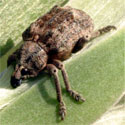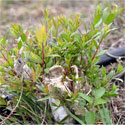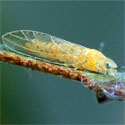Glossary
When clicked on, the images on this page open in a new window.
- Areawide: A pest-management program promoted by USDA/ARS that coordinates control strategies over a large area. This approach utilizes cooperation between researchers and institutions to pull all the pieces together over the entire affected area, and utilizes extension personnel to distribute information to public land managers and private land owners. An areawide approach was needed with melaleuca management because while public agencies made melaleuca management a priority on their lands, the tree continued to spread on private properties. Failure to address these trees means ignoring source populations of seeds, and failure to get the melaleuca population to tolerable levels.
- Biological control: The use of living natural enemies to control pests. As of spring 2004, two agents have been released in Florida to control melaleuca, and they are the melaleuca leaf weevil and the melaleuca psyllid.
- Exotic plant: A plant that is not native to the region in which it is growing. Melaleuca trees are not native to Florida, and hence are exotic plants. Not all exotic plants are bad, as crops, houseplants, and many ornamentals are exotic species.
- Integrated Pest Management (IPM): As it relates to melaleuca, an ecosystem-based strategy that focuses on the long-term reduction of melaleuca through a combination of techniques such as biological control, habitat manipulation, mechanical removal, and application of herbicides. Control methods are selected and applied in a manner that minimizes risks to human health, beneficial and nontarget organisms, and the environment. Prevention and prompt eradication of new infestations are important in this holistic and common-sense approach that utilizes extensive knowledge of melaleuca's life cycle. See Links for more information.
- Invasive plant: A plant that invades habitat beyond where it was planted. Invasive weeds are usually nonnative (exotic). Melaleuca is considered invasive because it has invaded marshes and pine flatwoods, and displaced (outcompeted) native vegetation in the process.
- Invasive, exotic plant: A plant that is not native to where it occurs, and one that is able to invade natural communities. Both melaleuca trees and its close relative, bottlebrush (a common Florida ornamental), are exotic species in Florida. However, because it spreads from where it is planted, melaleuca is considered an invasive exotic while bottlebrush is not.
- Melaleuca leaf weevil: A beetle released as a melaleuca biolocontrol agent in 1997. Scientific name is Oxyops vitiosa. Pictures in the photo gallery.
- Melaleuca psyllid: A biological control agent first released in South Florida in 2002. Scientific name is Boreioglycaspis melaleucae. Pictures in the photo gallery.
- Psyllids: A group of phloem-feeding insects (family Psyllidae, order Homoptera) that are related to aphids, coccids, and whiteflies. Psyllids are probably the most benign of these four insect groups and therefore the least well-studied.
Resources
There are two Web sites with many definitions of biological control terms (and other relevant terms) at the University of Florida and Cornell University.




